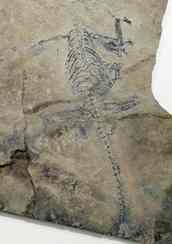For millions of years, Tany laid buried under layers of rock in what is now Hudson County.
She was unearthed in 1979 by a trio of amateur fossil hunters in an abandoned quarry: a rare, complete skeleton of a primitive reptile - one that swam through waterways in the northeast as dinosaurs began to roam the planet.
 But in the decades since her discovery, Tany has been stored out of state, modestly displayed in the lobby of a New York research laboratory.
But in the decades since her discovery, Tany has been stored out of state, modestly displayed in the lobby of a New York research laboratory.Now, she's back home. The fossil's founders, Steven and Trini Stelz and James Leonard, recently donated the 200-million-year-old specimen to the State Museum in Trenton. The tanytrachelos ahynis fossil - or Tany, as it's nicknamed - is already on display.
"I thought it should be in New Jersey," Steven Stelz said. "I thought it wasn't getting enough exposure."
But in Trenton, Tany is being praised as a gem of the museum's collection.
"We concentrate on New Jersey treasures," said David Parris, the museum's curator of natural history. "And this is certainly one of the greatest to come to us."
Encapsulated in slab of gray rock, the fossil is likely a female specimen, about a foot long, with a complete skeletal frame - something scientists say is extremely rare. All 128 of the reptile's bones, including its skull, are intact.
"To find any skeleton down to the last tail vertebrae is unheard of," Parris said. "We think it's the best specimen of this species ever found."
In life, the tanytrachelos - which means "long neck" in Greek - looked like a lizard and lived in the rift-valley-like lakes in eastern North America. It fed off insects and small aquatic life. And while it wasn't a dinosaur, it lived at the end of the Triassic period, when small dinosaurs first started to appear. Specimens have been found in Virginia, North Carolina and Pennsylvania, but scientists say only a couple have been uncovered in New Jersey.
Tany was discovered by a trio of 20-somethings who dug for fossils as a hobby. Steven Stelz was a teenager in the 1960s when he started chipping away at rocks in the abandoned Granton Quarry in the Hudson County town of North Bergen. He even took his future wife Trini to New York's Museum of Natural History on their first date.
Soon, she was tagging along at weekend fossil digs at Granton. A few months after they were married, the 21-year-olds started excavating a new part of the quarry with Jim Leonard, a friend from Pennsylvania.
Granton - which has been replaced by a strip mall - had produced a few fossils of fish and one ancient leaping reptile. But on an October day, the trio smashed into a piece of rock that split open, revealing a find that truly excited them.
"We knew right away it was something special," Steven Stelz, now 52, remembered recently from his rural home in Franklin Township in Hunterdon County, where he and Trini have lived for 20 years.
The trio took the specimen to Princeton University, where professor Donald Baird identified it. They then took the skeleton to Yale University in New Haven, Conn., where a student named Paul Olsen was studying. A year earlier, he had discovered the first tanytrachelos fossil while digging in North Carolina.
Olsen asked to study the Granton skeleton. After researching it at Yale, Olsen took the fossil with him when he moved to Columbia University's Lamont-Doherty Earth Observatory in Palisades, N.Y., just outside of Manhattan, in 1984.
"It has to go where the people are doing the research," Stelz explained.
But Stelz recently asked Olsen to return it to the Garden State so it could be studied further and admired by visitors wishing to learn about New Jersey's primitive past. The scientists there will try to learn more about its anatomy and history.
"I thought it was a splendid idea," Olsen said.
And it just so happens that Tany is joining the state museum as the exhibits there undergo renovation.
"It was perfect timing," Stelz said.
Source: The Star Ledger





